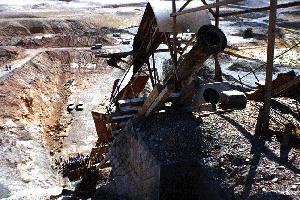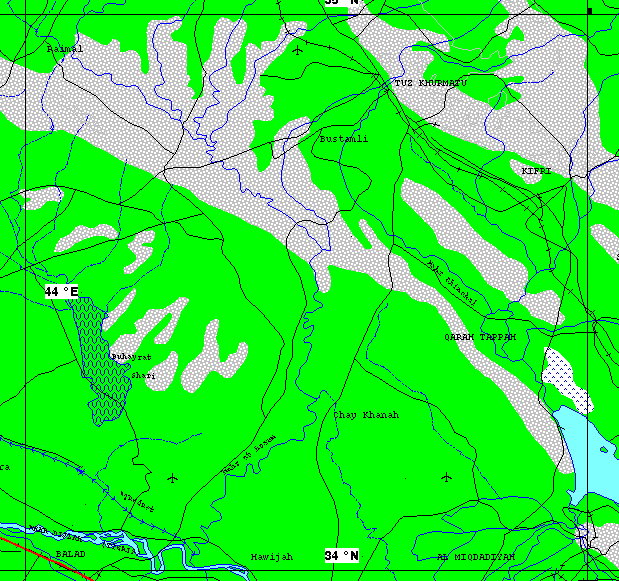





 Early in the war with Iran, the Iraqi government engaged world- renowned artillery expert Gerald V. Bull, whose lifetime obsession was a the construction of a "Supergun," a huge howitzer able to fire satellites into space or launch artillery shells thousands of miles into enemy territory. While he did not accomplish that dream, Bull did manage to
design some of the most effective artillery pieces in the world.
A Canadian-born astro-physicist, Bull had earlier research contracts with with the United States Army, the Canadian Department of Defense and McGill University. While working on the Canadian Velvet Glove missile project, he realized that scientific instruments could also be fired from a gun and survive if put in a proper casing. In 1962 Bull
obtained US military support for the joint U.S./Canadian High Altitude Research Program [HARP]. Initially working from a facility on the island of Barbados, a small 5-inch gun was used to fire projectiles to an altitude of over 70 km, and a 7-inch guns fired projectiles to nearly 100 km. Subsequently, in Arizona a larger HARP gun was fabricated by welding together a pair of 16-inch battleship guns, forming a barrel some 30 meters long. The gun was used to fire light-weight sub-caliber discarding-sabot projectiles called Martletts. On 19 November 1966 the gun fired a 185-lb Martlet to an altitude of 180 km. The 16 inch HARP gun was intended to launch a small three stage rocket carrying a 10 kg payload into space. However, the Canadian and US governments terminated HARP funding in 1967.
Early in the war with Iran, the Iraqi government engaged world- renowned artillery expert Gerald V. Bull, whose lifetime obsession was a the construction of a "Supergun," a huge howitzer able to fire satellites into space or launch artillery shells thousands of miles into enemy territory. While he did not accomplish that dream, Bull did manage to
design some of the most effective artillery pieces in the world.
A Canadian-born astro-physicist, Bull had earlier research contracts with with the United States Army, the Canadian Department of Defense and McGill University. While working on the Canadian Velvet Glove missile project, he realized that scientific instruments could also be fired from a gun and survive if put in a proper casing. In 1962 Bull
obtained US military support for the joint U.S./Canadian High Altitude Research Program [HARP]. Initially working from a facility on the island of Barbados, a small 5-inch gun was used to fire projectiles to an altitude of over 70 km, and a 7-inch guns fired projectiles to nearly 100 km. Subsequently, in Arizona a larger HARP gun was fabricated by welding together a pair of 16-inch battleship guns, forming a barrel some 30 meters long. The gun was used to fire light-weight sub-caliber discarding-sabot projectiles called Martletts. On 19 November 1966 the gun fired a 185-lb Martlet to an altitude of 180 km. The 16 inch HARP gun was intended to launch a small three stage rocket carrying a 10 kg payload into space. However, the Canadian and US governments terminated HARP funding in 1967.
Bull severed his association with the Pentagon in the 1970's and set up companies and agreements to sell improved versions of technology he developed to a number of foreign governments, including Iran, Chile, Taiwan and China. Working through his own Quebec firm, Space Research Corporation, and a Belgium subsidiary, European Poudreries Reunies de Belgique, Bull was able to produce his most formidable battlefield artillery piece, the GC-45 gun, known to fire a shell 25 miles with a throw weight twice that of guns used by Western armies. He was sentenced and jailed for one year in 1980 for illegally selling weapons to South Africa, despite the US arms embargo.
Shortly after the Iran-Iraq War began, the Iraqi government dispatched a private aircraft to Geneva to take Bull to Baghdad. So began a long association between Bull and the government of Iraq, and its then-defense minister, Saddam Hussein. Bull dealt with Iraq for almost 10 years. Iraq was one of many states with guns developed by Bull. His clients are known to include his native Canada, the United States, South Africa, Iran, Chile, Taiwan, China, and Libya. Most worrisome in Iraq's arsenal of guns developed by Gerald Bull from mid-1981 until he was assassinated on 22 March 1990, were its 300 155 millimeter howitzers, all versions of the GC-45 gun that Bull developed in the 1970's. Two hundred of these guns, termed GH-N-45 and manufactured in Austria, were shipped to Iraq via Jordan in 1985 for use in the Iran-Iraq war. The remaining 100 were manufactured in South Africa, where they are marketed under the name G-5. The G-5 can deliver a tactical nuclear warhead, chemical shells or any NATO standard 155mm shell. Bull also designed two advanced self-propelled artillery systems for the Iraqis: the 210-millimeter Al Fao and the 155 millimeter Majnoon. The Al Fao, which weighs 48 tons, can fire four 109 kilogram rounds a minute for 35 miles from its 11-meter barrel. The Iraqis claim that the Al Fao and Majnoon can attain a top speed of 72-88 kilometers an hour on the road. Also worrisome were Bull-modified missile warheads, which increased the range of Iraq's Scud missiles. Under Project Babylon, Bull extended his HARP gun design to build the barrel in segments, with a total length of 512 feet. The gun would be able to fire 600 kg projectile to a range of 1,000 kilometers, or a 2,000 kg rocket-assisted projectile into orbit.As a component of Project Babylon, Bull built a smaller gun, nick-named Baby Babylon, as a prototype for the larger gun. This 40 meter long gun was first constructed for horizontal testing in the summer of 1989, and installed at Jabal Hamrayn, ninety miles north of Baghdad, in central Iraq [Jabal Hamrin MTS 34�30'N 44�30'E]. The gun was positioned along a mountainside at an agle of about 45 degrees.

The high-ranking Iraqi defector Gen. Hussein Kamel al-Majeed said Iraq was working on a space weapon launched from the supergun.
"It was meant for long-range attack and also to blind spy satellites. Our scientists were seriously working on that. It was designed to explode a shell in space that would have sprayed a sticky material on the satellite and blinded it."He also said the supergun could have delivered a nuclear device. Following the Gulf War UN teams destroyed one 350 mm. supergun, components of a 1000 mm. supergun, and supergun propellant.
Iraq used the petrochemical complex two (PC-2) project as a front to purchase components for Gerald Bull's super gun. Matrix Churchill was a long established Midlands based machine tool manufacturer which was purchased in 1987 by an Iraqi controlled company, TMG Engineering Ltd, which was in turn controlled by another Iraqi controlled company, Technology and Development Group Ltd (TDG). The military uses of Matrix-Churchill machines are the prime reason Iraq was interested in purchasing the company. Acquiring Matrix-Churchill gave Iraq access, not only to the machine tools, but also the computer programming, tooling, and other components needed to make a wide variety of munitions as well as other applications in aerospace and nuclear industries. The Iraqi NASSR Establishment for Mechanical Industries contracted with the company for the supply of machine tools for a project, code named "ABA", to manufacture parts for multi launcher rocket systems. In addition, supergun components were fabricated in separate parts by factories in England, Spain, Holland and Switzerland. Acting on an anonymous tip, British Customs seized the final eight sections of the Super Gun in November 1990. The work skirted the law but remained legal, as illustrated by Britain's unsuccessful prosecution of the case, following the joint British-American sting operation that uncovered key supergun equipment transfers.

